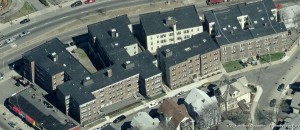 I read in the news this morning that a 2-year-old boy died when he fell from the roof of a 4-story apartment building in Dorchester, Massachusetts – about 25 miles from my home. Many of the news reports focus on the lack of supervision that allowed the toddler to leave the day care on the first floor, climb 4 flights of stairs to the roof, push the door to the roof open, and eventually fall. The lack of supervision is obviously a problem that needs to be addressed – even if he hadn’t made it to the roof he could have encountered other dangers after leaving the day care.
I read in the news this morning that a 2-year-old boy died when he fell from the roof of a 4-story apartment building in Dorchester, Massachusetts – about 25 miles from my home. Many of the news reports focus on the lack of supervision that allowed the toddler to leave the day care on the first floor, climb 4 flights of stairs to the roof, push the door to the roof open, and eventually fall. The lack of supervision is obviously a problem that needs to be addressed – even if he hadn’t made it to the roof he could have encountered other dangers after leaving the day care.
But what about the roof door? Boston City Councilor Tito Jackson said that the boy was able to “push through a door and get onto the roof.” But the Boston Inspectional Services Department issued a violation report which stated that the door must be “manually slammed shut to engage panic hardware.” It’s unclear how this door actually operates.
If the door swings out onto the roof and is equipped with panic hardware, it would allow unauthorized people onto the roof. If it swings into the stairs, it would be somewhat unusual to have panic hardware on the roof side, since the roof is not occupiable. In my opinion, roof doors should be locked to prevent access to the roof, and roof doors should be inspected to make sure they are closing and latching properly. If this roof was only accessed by repairmen or other authorized people, it would be surprising if they did not close and latch the door behind them when they last left the roof. This is not the first tragedy of this type, and future incidents can easily be avoided with proper security.
Here is a past Decoded article about roof access and egress.
How do you handle roof doors?
You need to login or register to bookmark/favorite this content.






In a large hospital setting, we are always vigilant for access to the roof. Patients sometimes bring in kids to a lobby and then they go up to visit their sick person, leaving the kids unsupervised. The kids can sometimes be found roving around the facility out of curiosity. If they can simply push a door open to the roof, they find the view fascinating but they have no judgment of the hazard associated with the height. Sometimes people who get very bad news will use the roof as a means to take their life. An incident of this nature always results in ruining reputations. There has been a concern in recent times about possible access to rooftop ventilation systems by someone who wants to commit an act of terrorism. There are probably many more reasons why access to a roof should be carefully controlled. What a sad situation.
Making a roof a portion of the means of exit egress from a building does not seem to be prudent. Perhaps the fire rated hardware (or panic hardware) was installed to allow the roof to be unlocked from the roof into the stairwell. but it would seem that the exposed actuating bar portion would be subject to weather damage. A normal passage set design for the outside would seem to be a better selection with free passage from the roof to the stairwell but key passage from the stairwell to the roof. I would use the type of lock that relocks upon withdrawal of the key so someone does not inadvertently leave it unlocked as they access the roof. Prevention of incidents is always better than trying to explain why you didn’t think of measures to take.
This is just plain sad, I have an 18 month old that has just learned to race up stairs and this breaks my heart.
Sad story and I thought of you as soon as I saw it on the news knowing the proximity…
Most people dont realize that the roof door is not a portion of most exit plans and should be secured to prevent tragedies like this.
A reverse storeroom with deadbolt function could have easily prevented this.
Ive seen other set ups where HVAC guys got stuck on the roof for awhile but I’ll take that any day over this outcome.
How about an Asylum function double cylinder lever-set? If the roof is accessible from another building or from climbing up, wouldn’t you want to secure it from that side as well?
Hi Nelson –
When a building owner needs security on the roof side, I usually use a double-cylinder deadbolt (as long as there isn’t a local code issue with that application). The deadbolt will help to ensure that the door won’t accidentally lock behind someone when they go onto the roof, but will allow the door to be locked in both directions. If the door is fire-rated, it will also need a passage latch for positive latching.
– Lori